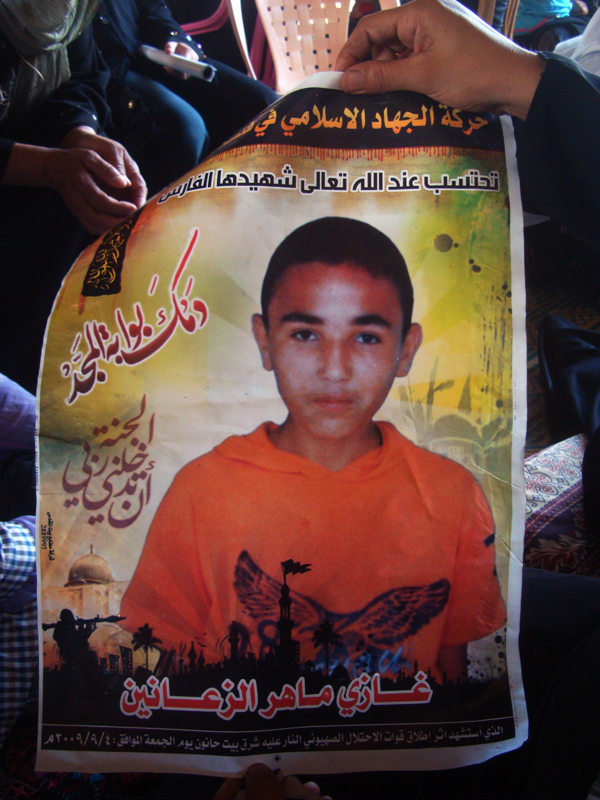 A 20-year-old Palestinian man, Sliman Abu Hanza, is in a critical condition in hospital after being shot in the abdomen with a ‘dum dum’ bullet at a demonstration in Al-Faraheen, Khan Younis, on Sunday.
A 20-year-old Palestinian man, Sliman Abu Hanza, is in a critical condition in hospital after being shot in the abdomen with a ‘dum dum’ bullet at a demonstration in Al-Faraheen, Khan Younis, on Sunday. The injury was inflicted during one of three non-violent demonstrations which took place on Sunday; in Beit Hanoun, Maghazi and Faraheen near Khan Younis – four members of the International Solidarity Movement also attended. The explode-on-impact ‘dum-dum’ bullet which hit Abu Hanza is the same type that was shot into the leg of Ahmed Deeb, 20, during a demonstration in Nahal Oz in April this year – severing his femeral artery and killing him.
All three demonstrations occurred at locations that have seen frequent protests against the Israeli-imposed ‘buffer zone’. This large area of land, along the Gazan side of the border, makes 35% of Gaza’s arable land, inaccessible to farmers because of the dangers of Israeli fire. The devastating effects on farmers and fisherman of these additional restrictions are outlined in a recent United Nations and World Food Programme report: ‘Between the fence and a hard place’ (opens as pdf).
The protests on Sunday targeted Israel’s continuous settlement building, which is in violation of international law and is further used to annex Palestinian land, a key tactic that accompanies the relentless ethnic cleansing of Palestinian Arabs from the region. Organiser and National Committee Secretary A’tah Abu Zarqa said the rallies were organised to show Palestinians’ vehement opposition to the Israeli policies that have expropriated Palestinian land on a continuous basis since Israel was created in 1948 on the ruins of Palestinian refugees. He said that the international community should never accept Israel’s attempts to unilaterally change the geography and demography of Palestine and that in light of this, Abbas should withdraw from negotiations immediately.
At the demonstrations in the Beit Hanoun and Maghazi, although live ammunition was used by Israeli occupation forces in the latter, there were no reported injuries. The demonstration in Maghazi was the first there since three protesters were shot and injured 5 months ago, including the International Solidarity Movement activist Bianca Zammit.
 In Faraheen. over 200 people attended the demonstration, which began as a procession towards the border with speeches and chanting, and a large women’s group was also present. A group of young men headed towards the border fence, still on Palestinian land. Sliman and a friend Kamal, also 20, planted flags near to the border fence. Kamal described what happened:
In Faraheen. over 200 people attended the demonstration, which began as a procession towards the border with speeches and chanting, and a large women’s group was also present. A group of young men headed towards the border fence, still on Palestinian land. Sliman and a friend Kamal, also 20, planted flags near to the border fence. Kamal described what happened:“I was with Sliman and we both put a flag near to the fence – just a flag. When the Israel Jeeps came they opened fired on us and I ran back for cover in a ditch. Suddenly I saw Sliman shot in his abdomen. It was clear it was a single shot intended to hit him. I helped carry him back over the fields with many others. He lives in the area near to the border.”
One of the major concerns for Sliman is the fact that he had to be carried over 500 metres across fields by many of the other demonstrators and then driven off in a ‘Tuk Tuk’ bike trailer to reach medical attention. This way of transporting casualties echoed the horrific scenes during the 3 week Israeli assault on Gaza over the New Year of 2009 when over 1400 people were killed including over 400 children. Because the medical services were so overwhelmed – and were often shot at when approaching the injured – many of the casualties were transported in the boots of cars or on donkey carts. A Press TV team captured the protest on film and interviewed ISM activist Adie Mormech about the shooting.
According to the Doctors at Europa hospital where he was taken, Sliman suffered extensive internal damage to his abdomen, 3 injuries to the small bowel, the left iliac vein, rectum and some intestinal damage. He has had a series of operations been given blood transfusions – the next 24 hours are crucial. Like Ahmed Deeb, the immediate threat to his life was from loss of blood sustained from his injuries. When ISM volunteers left the hospital after visiting Sliman yesterday, he was in a critical but stable condition and was about to be moved to the intensive care unit.
Sliman is another victim of the frequent attacks on civilians near to the border, many of which ended in fatalities such as the three farm workers killed in Beit Hanoun two weeks ago, and last Friday the fisherman Mohamed Bakri killed only 2 miles out at sea by an Israeli Gunship, a month before his wedding.
Besides the crippling and internationally condemned siege, Palestinian life in Gaza is littered with such tragedy, lives ended in a flicker in accordance with the whims of the Israeli sniper on duty and who he or she chooses for execution. If Sliman survives his injuries, he’s sure to join the thousands of Palestinians who must continue the rest of their imprisonment in the Gaza ghetto with permanent debilitating disabilities.
Despite this, people continue to demonstrate in large numbers across Gaza, preferring to face Israeli violence with nothing but flags and a desire to walk on their land, despite the risks that this shooting – all too common a story – exemplifies.

Updated on September 27, 2010



